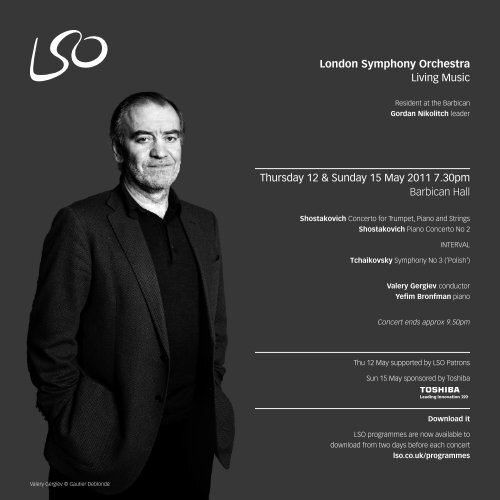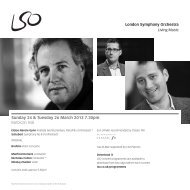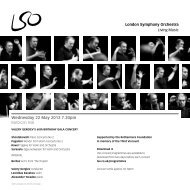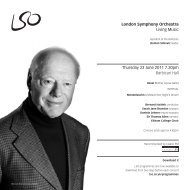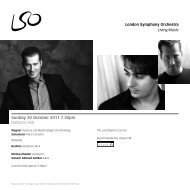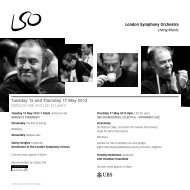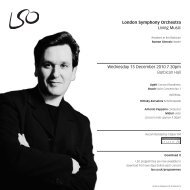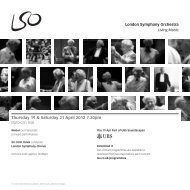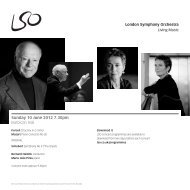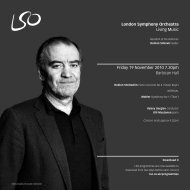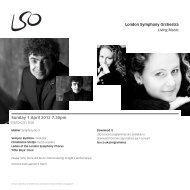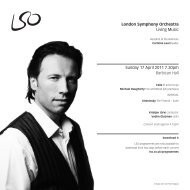Thursday 12 May programme - London Symphony Orchestra
Thursday 12 May programme - London Symphony Orchestra
Thursday 12 May programme - London Symphony Orchestra
Create successful ePaper yourself
Turn your PDF publications into a flip-book with our unique Google optimized e-Paper software.
Valery Gergiev © Gautier Deblonde<br />
<strong>London</strong> <strong>Symphony</strong> <strong>Orchestra</strong><br />
Living Music<br />
Resident at the Barbican<br />
Gordan Nikolitch leader<br />
<strong>Thursday</strong> <strong>12</strong> & Sunday 15 <strong>May</strong> 2011 7.30pm<br />
Barbican Hall<br />
Shostakovich Concerto for Trumpet, Piano and Strings<br />
Shostakovich Piano Concerto No 2<br />
INTERVAL<br />
Tchaikovsky <strong>Symphony</strong> No 3 (‘Polish’)<br />
Valery Gergiev conductor<br />
Yefim Bronfman piano<br />
Concert ends approx 9.50pm<br />
Thu <strong>12</strong> <strong>May</strong> supported by LSO Patrons<br />
Sun 15 <strong>May</strong> sponsored by Toshiba<br />
Download it<br />
LSO <strong>programme</strong>s are now available to<br />
download from two days before each concert<br />
lso.co.uk/<strong>programme</strong>s
Welcome News<br />
Welcome to these two concerts which see the third instalment of<br />
Principal Conductor Valery Gergiev’s Tchaikovsky <strong>Symphony</strong> Cycle.<br />
Yefim Bronfman makes a welcome return to the LSO performing<br />
as soloist tonight. Later in the month, the LSO and Gergiev take<br />
Tchaikovsky <strong>Symphony</strong> No 3 on tour in Switzerland to Bern, Geneva,<br />
Lugano, Zürich and Lucerne.<br />
I would like to take the opportunity to thank LSO Patrons for<br />
supporting the concert on <strong>12</strong> <strong>May</strong> and for the continued support<br />
from Toshiba who sponsors 15 <strong>May</strong>.<br />
I hope you enjoy the performance tonight and that you can join us<br />
for our next concert on 26 <strong>May</strong> when Sir Colin Davis continues his<br />
highly acclaimed cycle of Nielsen symphonies, joined by Mitsuko<br />
Uchida for the start of the LSO’s Beethoven Piano Concerto series.<br />
Kathryn McDowell<br />
LSO Managing Director<br />
2 Welcome & News<br />
LSO retired and past players’ reunion<br />
Since the LSO’s centenary in 2004 it has become an annual tradition<br />
to invite retired and past players to attend a Barbican concert.<br />
On 15 <strong>May</strong> we are joined by many former members of the <strong>Orchestra</strong> –<br />
a warm welcome back to all.<br />
Into the LSO: for our teenage audiences<br />
If you’re aged 13–18, or you know someone who is, join our free<br />
‘Into the LSO’ teens scheme and take advantage of cheap tickets,<br />
pre-concert events and exclusive chances to meet the LSO players.<br />
Before the concert on 15 <strong>May</strong> there will be a free talk introducing<br />
the evening’s music and you’ll also find some extra <strong>programme</strong><br />
notes for a quirky angle on the music!<br />
Find out more at lso.co.uk/intothelso<br />
Support the LSO’s Annual Fund<br />
The LSO’s Annual Fund gives you the opportunity to donate whatever<br />
you are able. Your gift will ensure that the LSO continues to make the<br />
finest music available to the greatest number of people. Every gift is<br />
important, however small.<br />
You can donate online and read stories of how the LSO has made a<br />
difference at lso.co.uk/annualfund<br />
Or you can donate £5 by text message now<br />
Text LSO DONATE5 to 60<strong>12</strong>3<br />
LSO Live wins double award at BBC Music Magazine Awards<br />
We are delighted to have won the BBC Music Magazine Disc of the<br />
Year Award for our LSO Live recording of Prokofiev’s Romeo and<br />
Juliet, as well as winning the Award in the orchestral category. The<br />
Disc of the Year Award was presented to the LSO by the composer’s<br />
grandson, Gabriel Prokofiev, at a ceremony at Kings Place (Gabriel<br />
is also appearing at LSO St Luke’s on 17 <strong>May</strong>). Pick up the <strong>May</strong> issue<br />
of BBC Music Magazine for a full feature on the award-winning<br />
recordings and an interview with the man at the helm, Valery Gergiev.<br />
Kathryn McDowell © Camilla Panufnik
Dmitri Shostakovich (1906–1975)<br />
Concerto for Trumpet, Piano and Strings Op 35 (1933)<br />
1 Allegretto<br />
2 Moderato<br />
3 Lento<br />
4 Allegro con brio<br />
Yefim Bronfman piano<br />
Philip Cobb trumpet<br />
As a young man Shostakovich had ambitions to become a composer-<br />
pianist in the mould of Rachmaninov or Prokofiev, and by his early<br />
twenties he had gained a notable position in Russia as a solo pianist.<br />
In 1927 he had even been one of the Russian competitors at the<br />
Chopin Competition in Warsaw, though he achieved only an honourable<br />
mention. His performing style was very individual. ‘Shostakovich<br />
emphasised the linear aspect of music and was very precise in all<br />
the details of performance,’ recalled a friend, ‘he used little rubato<br />
in his playing, and it lacked extreme dynamic contrasts. It was an<br />
‘anti-sentimental’ approach to playing which showed incredible<br />
clarity of thought.’<br />
He wrote this concerto for himself to play, composing it soon after<br />
completing the opera Lady Macbeth of Mtsensk and the 24 Preludes<br />
for Piano, and gave the first performance with members of the<br />
Leningrad Philharmonic conducted by Fritz Stiedry on 13 October 1933.<br />
Shostakovich twice recorded the work, and there is even a brief film<br />
clip of him playing the finale at a recklessly fast tempo.<br />
For a decade Shostakovich had taken full advantage of the excitement<br />
and confusion that reigned in post-Revolutionary Russia, producing<br />
a vast body of work that ranged from the modernist brutalism of<br />
the Second and Third Symphonies to the biting satire of The Nose,<br />
from light-hearted ballet scores to the deep seriousness of Lady<br />
Macbeth of Mtsensk. The concerto is one of his most accessible<br />
and justly popular works from this period. Short and compact, the<br />
concerto constantly teases the listener with half-quotations, parodies<br />
and sudden changes of direction. Although it has its moments of<br />
seriousness, they are more apparent than real and tend to be swept<br />
aside by the anarchic humour which was a speciality of the young<br />
Shostakovich. Influences of Ravel, Prokofiev, Gershwin and Stravinsky<br />
4 Programme Notes<br />
can be heard, but equally important is Shostakovich’s own approach<br />
to music for stage and film.<br />
One account suggests that Shostakovich’s initial idea was for a solo<br />
trumpet concerto. Whether there is any truth in this or not, the final<br />
result is by no means a double concerto for equally-matched soloists,<br />
for the piano is very much in the foreground all the time. The trumpet<br />
plays a major role, however, often a thoroughly subversive one, and<br />
achieves a kind of lunatic glory in the Rossini-meets-Mickey-Mouse<br />
conclusion.<br />
Programme note © Andrew Huth<br />
More great pianists with the LSO this summer…<br />
Thu 26 <strong>May</strong> 7.30pm<br />
Beethoven Piano Concerto No 2<br />
with Mitsuko Uchida piano<br />
Thu 2 Jun 7.30pm<br />
Beethoven Piano Concerto No 1<br />
with Mitsuko Uchida piano<br />
Tue 14 & Thu 16 Jun 7.30pm<br />
Schumann Piano Concerto<br />
with Murray Perahia piano<br />
Tickets from £8<br />
Choose your own seats online at<br />
lso.co.uk or call 020 7638 8891
Dmitri Shostakovich (1906–1975)<br />
Piano Concerto No 2 in F Major Op 102 (1957)<br />
1 Allegro<br />
2 Andante<br />
3 Allegro<br />
Yefim Bronfman piano<br />
Shostakovich composed six concertos altogether, but while the<br />
two violin concertos (both intended for David Oistrakh) and the two<br />
cello concertos (for Mstislav Rostropovich) count among his most<br />
searching, personal works, the piano concertos are very much on the<br />
lighter side. They also show the radical differences that Shostakovich’s<br />
approach to composition had undergone in 24 years. The first, for<br />
all its good humour, was a product of Russian post-revolutionary<br />
modernism where the high spirits are expressed through a kaleidoscope<br />
of teasing parodies. By the time he composed the Second Piano<br />
Concerto, he had undergone two official condemnations and had<br />
learned to avoid trouble by adopting a more restrained language,<br />
which in his darker and more serious works becomes a mask where<br />
classical forms and procedures are moulded to his own purposes.<br />
That said, the Second Piano Concerto is one of the most straight-<br />
forward and uncomplicated pieces he ever composed, its humour<br />
untinged by sarcasm or bitterness. He wrote it not for himself but for<br />
his son Maxim, who gave the first performance on his 19th birthday<br />
on 10 <strong>May</strong> 1957 (three years earlier Shostakovich had written the<br />
little Concertino for Two Pianos for father and son to play together).<br />
Maxim was a fine pianist but never aimed to become a great virtuoso.<br />
Although the Concerto’s solo writing is always highly effective,<br />
it avoids the bravura and extreme difficulties of the First.<br />
The Second Piano Concerto is as lighthearted as the First, though in a<br />
gentler and perhaps more innocent way. There is nothing provocative,<br />
controversial or experimental here, just the skill and imagination that<br />
Shostakovich devoted to all his music, whether deeply serious or<br />
intended mainly for entertainment. The Concerto’s outward shape<br />
is quite conventional, with a three-movement structure and clear<br />
cut form, so that nothing disturbs its simplicity and directness.<br />
The first movement is in a quick march tempo, its character set by<br />
the bassoon opening; the initial piano texture – left and right hands<br />
playing one or two octaves apart – is a common feature of the solo<br />
writing throughout the Concerto. The second movement, with reduced<br />
orchestra, has the mood and textures of a nocturne. It leads directly<br />
into the high-spirited finale, where the basic duple metre is wittily<br />
subverted by the 7/8 metre of the secondary theme.<br />
Programme note © Andrew Huth<br />
Dmitri Shostakovich – Composer Profile<br />
After early piano lessons with his mother, Shostakovich enrolled at the<br />
Petrograd Conservatoire in 1919. He announced his Fifth <strong>Symphony</strong><br />
of 1937 as ‘a Soviet artist’s practical creative reply to just criticism’.<br />
A year before its premiere he had drawn a stinging attack from<br />
Soviet mouthpiece Pravda, in which his initially successful opera<br />
Lady Macbeth of the Mtsensk District was condemned for its extreme<br />
modernism. With the Fifth <strong>Symphony</strong> came acclaim not only from<br />
the Russian audience, but also from musicians and critics overseas.<br />
Shostakovich lived through the first months of the German siege of<br />
Leningrad serving as a member of the auxiliary fire service. In July<br />
he began work on his Seventh <strong>Symphony</strong>, completing the defiant<br />
finale after his evacuation in October, dedicating the score to the<br />
city. A copy was despatched by way of an American warship to<br />
the US, where it was broadcast by the NBC <strong>Symphony</strong> <strong>Orchestra</strong>.<br />
In 1943 Shostakovich completed his Eighth <strong>Symphony</strong>, its emotionally<br />
shattering music compared by one critic to Picasso’s Guernica.<br />
In 1948 Shostakovich and other leading composers were forced by<br />
the Soviet cultural commissar, Andrey Zhdanov, to concede that their<br />
work represented ‘most strikingly the formalistic perversions and<br />
anti-democratic tendencies in music’, a crippling blow to his artistic<br />
freedom that was healed only after the death of Stalin in 1953.<br />
Shostakovich answered his critics later that year with the powerful<br />
Tenth <strong>Symphony</strong>, in which he portrays ‘human emotions and<br />
passions’, rather than the collective dogma of Communism.<br />
Profile © Andrew Stewart<br />
Programme Notes<br />
5
Pyotr Ilych Tchaikovsky (1840–1893)<br />
<strong>Symphony</strong> No 3 in D Major Op 29 (‘Polish’) (1875)<br />
1 Moderato assai (Tempo di marcia funebrae) – Allegro brillante<br />
2 Alla tedesca<br />
3 Andante<br />
4 Scherzo<br />
5 Allegro con fuoco (Tempo di polacca)<br />
Composed between two of his most popular works, the First<br />
Piano Concerto and Swan Lake, Tchaikovsky’s Third <strong>Symphony</strong><br />
deliberately avoids the expression of any deep personal emotion<br />
but demonstrates instead the composer’s growing involvement<br />
in a wider and more objective symphonic tradition. It was written<br />
in the summer of 1875, when Tchaikovsky was free of his teaching<br />
duties at the Moscow Conservatory. Visiting the country houses of<br />
friends and relatives, he drafted the symphony in barely two weeks<br />
and then took enormous trouble over the final orchestral score.<br />
It was first performed on 19 November 1875 in Moscow, conducted<br />
by Nikolay Rubinstein.<br />
The nickname ‘Polish’, which seems to have been coined when<br />
Sir August Manns gave the symphony its first British performance<br />
at the Crystal Palace in 1899, is quite irrelevant. While the Second<br />
<strong>Symphony</strong> is known as the ‘Ukrainian’ or ‘Little Russian’ because it<br />
makes prominent use of Ukrainian folk tunes, the finale of the Third<br />
features the polonaise not as an expression of national colour but<br />
simply as a stylised dance rhythm. Tchaikovsky was consciously<br />
moving away from his brief but close involvement with the Russian<br />
national composers, finding their dogmatic approach too restricting.<br />
Instead of a heavy dependence on folk themes, which may be<br />
colourful in themselves but tend to be self-contained, Tchaikovsky<br />
is here working with material that is on the surface less distinctive,<br />
but which allows for more elaborate development and more subtle<br />
relationships between themes and movements. Even so, every<br />
detail of the symphony bears the personal stamp of the composer<br />
who admitted that ‘As regards the Russian element in general in my<br />
music … I grew up in the backwoods, saturating myself from earliest<br />
childhood with the inexplicable beauty of the characteristics of<br />
Russian folksong’.<br />
6 Programme Notes<br />
Tchaikovsky’s only symphony in a major key opens with a minor-key<br />
introduction, Tempo di marcia funebre, but this funeral march is more<br />
an indication of style and tempo than any particular expression of<br />
grief. Halting phrases in the dominant key build up suspense with a<br />
gradual acceleration towards the main body of the movement, whose<br />
three themes are treated with many inventive rhythmic shifts.<br />
The three central movements are more lightly scored. The Alla<br />
tedesca, a German dance, is in George Balanchine’s description<br />
‘another of Tchaikovsky’s marvellous waltzes, a whole ballet scene<br />
exquisitely orchestrated’. The central trio keeps the same basic pulse<br />
but sounds faster because of the shorter note-values, a stream of<br />
quaver triplets with a distinct flavour of Schumann or Mendelssohn.<br />
The wind solos that open the deeply expressive slow movement mark<br />
it as both the most Russian and the most personal music heard so far.<br />
The triplet figures that appear later can be heard as a development of<br />
those in the second movement, and are heard to very evocative effect<br />
in the coda, with its echoes of Berlioz’ Symphonie fantastique. In the<br />
fourth movement orchestral texture becomes an essential part of the<br />
music’s effect: the strings are muted throughout, giving a spectral<br />
quality to what is essentially a single line of running semiquavers.<br />
For the opening of the trio section Tchaikovsky recycled an idea<br />
from a cantata he had hastily written three years earlier for the<br />
bicentenary of the birth of Peter the Great.<br />
The finale mirrors the first movement as an exercise in orchestral<br />
sonority and brilliance. While for Chopin the Polonaise was a vehicle<br />
for his patriotism, proud, heroic or tragic by turns, Tchaikovsky here<br />
treats the dance as something grand and ceremonial, as he would do<br />
again two years later to convey the aristocratic world of St Petersburg<br />
at the opening of the last act of Eugene Onegin.<br />
Programme note © Andrew Huth<br />
Andrew Huth is a musician, writer and translator who writes<br />
extensively on French, Russian and Eastern European music.
Valery Gergiev<br />
Conductor<br />
‘The vigour of Gergiev’s interpretation,<br />
all darting flashes of colour and<br />
contrast, was immensely appealing’<br />
The Guardian on Valery Gergiev<br />
and the LSO, March 11<br />
Principal Conductor of the <strong>London</strong> <strong>Symphony</strong><br />
<strong>Orchestra</strong> since January 2007, Valery Gergiev<br />
performs regularly with the LSO at the Barbican,<br />
at the Proms and at the Edinburgh Festival,<br />
as well as on regular tours of Europe, North<br />
America and Asia. During the 2010/11 season<br />
has led them in appearances in Germany,<br />
France, Switzerland, Japan and the US.<br />
Valery Gergiev is also Artistic and General<br />
Director of the Mariinsky Theatre, founder<br />
and Artistic Director of the Stars of the<br />
White Nights Festival and New Horizons<br />
Festival in St Petersburg, the Moscow Easter<br />
Festival, the Gergiev Rotterdam Festival, the<br />
Mikkeli International Festival, and the Red<br />
Sea Festival in Eilat, Israel. He succeeded<br />
Sir Georg Solti as conductor of the World<br />
Valery Gergiev © Gautier Deblonde<br />
<strong>Orchestra</strong> for Peace in 1998 and has led them<br />
this season in concerts in Abu Dhabi.<br />
Gergiev’s inspired leadership of the Mariinsky<br />
Theatre since 1988 has taken the Mariinsky<br />
ensembles to 45 countries and has brought<br />
universal acclaim to this legendary institution,<br />
now in its 227th season. Having opened a new<br />
concert hall in St Petersburg in 2006, Maestro<br />
Gergiev looks forward to the opening of the<br />
new Mariinsky Opera House in summer 20<strong>12</strong>.<br />
Born in Moscow, Valery Gergiev studied<br />
conducting with Ilya Musin at the Leningrad<br />
Conservatory. Aged 24 he won the Herbert<br />
von Karajan Conductors Competition in Berlin<br />
and made his Mariinsky Opera debut one<br />
year later in 1978 conducting Prokofiev’s<br />
War and Peace. In 2003 he led St Petersburg’s<br />
300th anniversary celebrations, and opened<br />
the Carnegie Hall season with the Mariinsky<br />
<strong>Orchestra</strong>, the first Russian conductor to do<br />
so since Tchaikovsky conducted the Hall’s<br />
inaugural concert in 1891.<br />
Now a regular figure in all the world’s major<br />
concert halls, this season he led the LSO<br />
and the Mariinsky <strong>Orchestra</strong> in a symphonic<br />
Centennial Mahler Cycle in New York. Gergiev<br />
has led several cycles previously in New York<br />
including Shostakovich, Stravinsky, Prokofiev,<br />
Berlioz and Richard Wagner’s Ring. He has<br />
also introduced audiences to several rarely<br />
performed Russian operas.<br />
Valery Gergiev’s many awards include a<br />
Grammy, the Dmitri Shostakovich Award,<br />
the Golden Mask Award, People’s Artist of<br />
Russia Award, the World Economic Forum’s<br />
Crystal Award, Sweden’s Polar Music Prize,<br />
Netherlands’ Knight of the Order of the Dutch<br />
Lion, Japan’s Order of the Rising Sun, Valencia’s<br />
Silver Medal, the Herbert von Karajan prize and<br />
the French Order of the Legion of Honour.<br />
He has recorded exclusively for Decca<br />
(Universal Classics), and appears also on<br />
the Philips and Deutsche Grammophon<br />
labels. Currently recording for LSO Live,<br />
his releases include Mahler Symphonies<br />
Nos 1–8, Rachmaninov <strong>Symphony</strong> No 2,<br />
Prokofiev Romeo and Juliet which won the<br />
BBC Music Magazine Disc of the Year and<br />
Bartók Duke Bluebeard’s Castle.<br />
His recordings on the Mariinsky Label are<br />
Shostakovich The Nose and Symphonies<br />
Nos 1, 2, 11 and 15, Tchaikovsky 18<strong>12</strong> Overture,<br />
Rachmaninov Piano Concerto No 3 and<br />
Rhapsody on a Theme of Paganini, Rodion<br />
Shchedrin The Enchanted Wanderer,<br />
Stravinsky Les Noces and Oedipus Rex<br />
and Wagner Parsifal, many of which have<br />
also won awards, including four Grammy<br />
nominations.<br />
The Artists<br />
7
Yefim Bronfman<br />
Piano<br />
‘A marvel of digital dexterity,<br />
warmly romantic sentiment,<br />
and jaw-dropping bravura.’<br />
The Chicago Tribune on<br />
Yefim Bronfman, March 11<br />
Yefim Bronfman is widely regarded as<br />
one of the most talented virtuoso pianists<br />
performing today. His commanding technique<br />
and exceptional lyrical gifts have won him<br />
consistent critical acclaim and enthusiastic<br />
audiences worldwide, whether for his solo<br />
recitals, his prestigious orchestral engagements<br />
or his rapidly growing catalogue of recordings.<br />
Yefim Bronfman emigrated to Israel with his<br />
family in 1973, and made his international<br />
debut two years later with Zubin Mehta and<br />
the Montreal <strong>Symphony</strong>. He made his New<br />
York Philharmonic debut in <strong>May</strong> 1978, his<br />
Washington recital debut in March 1981 at<br />
the Kennedy Center and his New York recital<br />
debut in January 1982.<br />
Bronfman was born in Tashkent, in the Soviet<br />
Union, on 10 April 1958. In Israel he studied<br />
with pianist Arie Vardi, head of the Rubin<br />
Academy of Music at Tel Aviv University.<br />
In the United States, he studied at The Juilliard<br />
School, Marlboro and the Curtis Institute,<br />
and with Rudolf Firkusny, Leon Fleisher<br />
and Rudolf Serkin.<br />
Bronfman’s 2010/11 European season<br />
highlights included a tour with the Vienna<br />
Philharmonic playing the concerto written<br />
for him by Esa-Pekka Salonen and with<br />
Salonen and the Philharmonia <strong>Orchestra</strong>,<br />
a two-season project of the three Bartók<br />
concertos. In partnership with Berlin’s<br />
Staatskapelle and Daniel Barenboim, all three<br />
Bartók concertos will again be featured in<br />
Berlin, Vienna and Paris. Return engagements<br />
in Europe include the Berlin Philharmonic,<br />
Royal Concertgebouw, Israel Philharmonic,<br />
Frankfurt Radio, Santa Cecilia Rome and<br />
Munich Philharmonic.<br />
Bronfman works regularly with an illustrious<br />
group of conductors, including Daniel<br />
Barenboim, Herbert Blomstedt, Christoph<br />
von Dohnányi, Charles Dutoit, Christoph<br />
Eschenbach, Valery Gergiev, Mariss Jansons,<br />
Lorin Maazel, Kurt Masur, Zubin Mehta,<br />
Esa-Pekka Salonen, Yuri Temirkanov, Franz<br />
Welser-Möst, and David Zinman. Summer<br />
engagements have regularly taken him to<br />
the major festivals of Europe and the US.<br />
Widely praised for his solo, chamber and<br />
orchestral recordings, he was awarded a<br />
Grammy in 1997 for his recording of the<br />
three Bartók Piano Concertos with Esa-Pekka<br />
Salonen and the Los Angeles Philharmonic.<br />
His discography also includes the complete<br />
Prokofiev Piano Sonatas; all five of the<br />
Prokofiev Piano Concertos, nominated for<br />
both Grammy and Gramophone Awards; and<br />
Rachmaninov’s Piano Concertos Nos 2 and 3.<br />
His most recent releases are Tchaikovsky’s<br />
Piano Concerto No 1 with Mariss Jansons and<br />
the Symphonieorchester des Bayerischen<br />
Rundfunks, a recital disc Perspectives to<br />
complement Bronfman’s designation as a<br />
Carnegie Hall ‘Perspectives’ artist for the<br />
2007/08 season, and recordings of all the<br />
Beethoven Piano Concertos as well as the<br />
Triple Concerto together with violinist<br />
Gil Shaham, cellist Truls Mørk and the<br />
Tönhalle <strong>Orchestra</strong> Zürich under David<br />
Zinman for the Arte Nova/BMG label. His<br />
recordings with Isaac Stern include the<br />
Brahms Violin Sonatas, a cycle of the Mozart<br />
Sonatas for Violin and Piano, and the Bartók<br />
Violin Sonatas. Coinciding with the release<br />
of the Fantasia 2000 soundtrack, Bronfman<br />
was featured on his own Shostakovich album,<br />
performing the two Piano Concertos with<br />
the Los Angeles Philharmonic and Esa-Pekka<br />
Salonen conducting, and the Piano Quintet.<br />
In 2002, Sony Classical released his two-<br />
piano recital (with Emanuel Ax) of works<br />
by Rachmaninov, which was followed in<br />
March 2005 by their second recording of<br />
works by Brahms.<br />
8 The Artists Yefim Bronfman © Dario Acosta
Philip Cobb<br />
Trumpet<br />
As a youngster, Philip regularly featured as a soloist on both the<br />
cornet and the trumpet throughout the UK and abroad alongside his<br />
brother Matthew and their father Stephen. In more recent years he<br />
has appeared as a soloist in his own right, and was recently featured<br />
as a solo performer in <strong>London</strong>’s Royal Albert Hall, as well as at the<br />
International Trumpet Guild conference in Boston, US.<br />
Philip is a former student of the Guildhall School of Music and Drama,<br />
having studied with Principal Trumpet of the <strong>London</strong> Philharmonic<br />
<strong>Orchestra</strong>, Paul Beniston, and also with renowned trumpet soloist<br />
Alison Balsom. Shortly after graduation and following trials with<br />
the <strong>London</strong> Philharmonic and Hallé orchestras, Philip accepted<br />
his current position as Principal Trumpet with the LSO.<br />
In 2006 Philip competed in the prestigious Maurice André International<br />
Trumpet Competition. With former prize winners going on to achieve<br />
international acclaim as both soloists and orchestral performers,<br />
Philip was awarded one of the major prizes in the competition as<br />
the Most Promising Performer. He was also awarded the ‘Candide<br />
Award’ at the <strong>London</strong> <strong>Symphony</strong> <strong>Orchestra</strong>’s Brass Academy in 2008.<br />
In September 2007 Philip released his debut solo CD, Life Abundant,<br />
with the Cory Band and Organist Ben Horden.<br />
Gergiev’s Tchaikovsky<br />
Further your Tchaikovsky experience<br />
and join Valery Gergiev and the LSO on<br />
a journey through the quintessentially<br />
Romantic composer’s complete<br />
symphonies.<br />
Wed 21 Sep 2011<br />
All-Tchaikovsky <strong>programme</strong> featuring<br />
the winners of the XIV International<br />
Tchaikovsky Competition<br />
Sun 25 Sep 2011<br />
Tchaikovsky <strong>Symphony</strong> No 4<br />
Brahms Piano Concerto No 1<br />
with Nelson Freire<br />
Thu 24 Nov 2011<br />
Tchaikovsky <strong>Symphony</strong> No 5<br />
Sofia Gubaidulina Fachwerk<br />
with Geir Draugsvoll<br />
Prokofiev <strong>Symphony</strong> No 1 (‘Classical’)<br />
Thu 23 Feb 20<strong>12</strong><br />
Tchaikovsky <strong>Symphony</strong> No 6<br />
(‘Pathétique’)<br />
Shostakovich Violin Concerto No 1<br />
with Sarah Chang<br />
Tickets from £10 on sale now<br />
Box Office<br />
020 7638 8891 (bkg fee)<br />
lso.co.uk (reduced bkg fee)<br />
<strong>London</strong> <strong>Symphony</strong> <strong>Orchestra</strong><br />
Living Music<br />
The Artists<br />
9
10<br />
The Symphonies of Pyotr Ilyich Tchaikovsky<br />
by Andrew Huth<br />
Tchaikovsky’s symphonies<br />
are both musical and human<br />
dramas, and he took the<br />
writing of them very seriously.<br />
He certainly didn’t see the symphony as an abstract formal idea.<br />
Defending the Fourth in a letter to his favourite pupil Sergei Taneyev,<br />
he wrote ‘I should be sorry if symphonies that mean nothing should<br />
flow from my pen, consisting solely of a progression of harmonies,<br />
rhythms and modulations’. He went on to call the symphony<br />
‘the most purely lyrical of musical forms. Shouldn’t a symphony<br />
reveal those wordless urges that hide in the heart, asking earnestly<br />
for expression?’.<br />
That is a very Romantic, 19th-century point of view, just what we’d<br />
expect from so volatile and emotional a composer as Tchaikovsky.<br />
What it doesn’t reflect is the intellectual effort he devoted to each<br />
of his six symphonies. He hated theorising, particularly in public, and<br />
distrusted verbal explanations, but the fact remains that in order to<br />
express those ‘wordless urges’, he had to think deeply and carefully<br />
about the ‘harmonies, rhythms and modulations’ which are essential<br />
to large-scale form and structure. It was often a difficult process for<br />
him. A letter written to his brother Anatoly while he was composing<br />
the First <strong>Symphony</strong> could stand for all his troubles. He complains<br />
about his nerves (‘...in an awful state because of my symphony, which<br />
is not going well at all...’); to habitual self-doubt he adds a touch of<br />
Tchaikovsky’s Symphonies<br />
self-pity (‘...the thought that I am going to die soon and will not have<br />
time to finish my symphony’) and, for good measure, includes the sort<br />
of resolution he was to make and break until the end of his life<br />
(‘Since yesterday I have stopped drinking vodka, wine and strong tea’).<br />
The First <strong>Symphony</strong> turned out to be full of natural, spontaneous<br />
talent, and contains everything that listeners have always prized in<br />
Tchaikovsky’s music. Later works would be more subtly composed;<br />
but from the beginning there is colour, drama, melody, and an<br />
unmistakable personality in this music. Mendelssohn and Schumann<br />
are the closest models for its overall shape, although the music never<br />
sounds like either of these, or indeed any other German composer:<br />
Tchaikovsky was particularly careful not to recall the procedures or<br />
gestures of Beethoven, who was in many ways his exact opposite as<br />
both man and musician.<br />
With the Second <strong>Symphony</strong>, it seemed that the young Tchaikovsky<br />
had identified himself closely with the aims of the Russian Nationalist<br />
composers. They greatly admired its vigorous, clear orchestration,<br />
especially the fresh wind writing; but what they most prized was<br />
the way in which Tchaikovsky found apparently endless ways of
presenting his folk-like material, inventing accompaniments and<br />
variations that preserved the original character of the melodies while<br />
showing them off from ever-varying perspectives. The Third, however,<br />
marks a step away from Nationalism towards a more objective and<br />
international style. With its five movements, it is actually closer to<br />
Tchaikovsky’s idea of a suite than a symphony, and its somewhat<br />
detached emotional character has caused it to be the least known of<br />
the six – unjustly, for it was an important step towards the remarkable<br />
achievements of the last three symphonies.<br />
‘Shouldn’t a symphony reveal<br />
those wordless urges that<br />
hide in the heart, asking<br />
earnestly for expression?’<br />
Pyotr Ilyich Tchaikovsky<br />
In each of these works Tchaikovsky had to discover a new kind of<br />
balance between the demands of symphonic structure and his<br />
personal lyrical style. Expressive melody is always the most striking<br />
feature, and the melodic current that leads the listener through these<br />
large structures is designed to articulate an inner drama. The original<br />
features of the Fourth are mainly concerned with the material itself<br />
(the ‘harmonies, rhythms and modulations’), and the symphony’s overall<br />
shape reveals an almost desperately-willed progress from internal to<br />
external, from the self-obsessed first movement, through reflections of<br />
the past and the outer world, to images of ‘the people’ in the finale –<br />
something which may very well reflect Tchaikovsky’s admiration for<br />
Tolstoy, whose Anna Karenina had recently been serialised.<br />
Ten years separate the Fourth from the Fifth, a period during which<br />
Tchaikovsky’s life had become more stable and his audience more<br />
international. The Fifth is more self-contained, more consciously<br />
related to Western symphonic traditions, and aims (with some<br />
curiously ambiguous results) to be more balanced emotionally.<br />
There is little sign of the traditional German fondness for close<br />
motivic relationships, but the clinging melancholy and nostalgia<br />
that is so much a part of Tchaikovsky’s character is set within a<br />
traditionally classical structure that balances inward melancholy<br />
against an aspiration towards outward-looking strength.<br />
Tchaikovsky’s great achievement in the Sixth was to devise a<br />
structure which seems to arise from the nature of the melodic ideas<br />
themselves. It is a drama of contrasts, or in the terms Tchaikovsky<br />
himself was obviously thinking of, personal passion struggling<br />
against hostile forces. Questions of the correct balance between<br />
lyrical expression and formal balance, between Western and Russian<br />
approaches, are irrelevant in the face of this music’s overwhelming<br />
emotional effect. In the 19th century a symphony beginning in a minor<br />
key was generally planned as a darkness-to-light affair. The slow-<br />
to-slow, darkness-to-darkness of Tchaikovsky’s Sixth contradicts all<br />
expectations, and its bleak message is conveyed with a power that<br />
leaves one in no doubt either of Tchaikovsky’s musical mastery or the<br />
strength of his feelings. It is one of those rare works which open up<br />
new areas of musical experience.<br />
Article © Andrew Huth<br />
Send us your thoughts on<br />
tonight’s concert<br />
Using a smartphone QR code reader,<br />
scan this barcode to be taken to our<br />
mobile site Reviews page, or visit<br />
londonsymphonyorchestra.mobi<br />
Tchaikovsky’s Symphonies<br />
11
On stage<br />
First Violins<br />
Gordan Nikolitch Leader<br />
Carmine Lauri<br />
Lennox Mackenzie<br />
Nigel Broadbent<br />
Ginette Decuyper<br />
Jörg Hammann<br />
Michael Humphrey<br />
Maxine Kwok-Adams<br />
Claire Parfitt<br />
Harriet Rayfield<br />
Colin Renwick<br />
Ian Rhodes<br />
Sylvain Vasseur<br />
Alina Petrenko<br />
Erzsebet Racz<br />
Sarah Sew<br />
Second Violins<br />
Evgeny Grach<br />
Sarah Quinn<br />
Miya Vaisanen<br />
David Ballesteros<br />
Matthew Gardner<br />
Belinda McFarlane<br />
Iwona Muszynska<br />
Philip Nolte<br />
Paul Robson<br />
Caroline Frenkel<br />
Oriana Kriszten<br />
Katerina Mitchell<br />
Stephen Rowlinson<br />
Julia Rumley<br />
<strong>12</strong> The <strong>Orchestra</strong><br />
Violas<br />
Edward Vanderspar<br />
Gillianne Haddow<br />
Malcolm Johnston<br />
Regina Beukes<br />
German Clavijo<br />
Richard Holttum<br />
Robert Turner<br />
Nancy Johnson<br />
Martin Schaefer<br />
Michelle Bruil<br />
Philip Hall<br />
Caroline O’Neill<br />
Cellos<br />
Timothy Hugh<br />
Floris Mijnders<br />
Alastair Blayden<br />
Jennifer Brown<br />
Mary Bergin<br />
Noel Bradshaw<br />
Daniel Gardner<br />
Hilary Jones<br />
Amanda Truelove<br />
Susan Sutherley<br />
Double Basses<br />
Rinat Ibragimov<br />
Nicholas Worters<br />
Patrick Laurence<br />
Michael Francis<br />
Jani Pensola<br />
Simo Vaisanen<br />
Benjamin Griffiths<br />
Adam Wynter<br />
Flutes<br />
Gareth Davies<br />
Adam Walker<br />
Patricia Moynihan<br />
Piccolo<br />
Sharon Williams<br />
Oboes<br />
Emanuel Abbühl<br />
Emmanuel Laville<br />
Katie Bennington<br />
Clarinets<br />
Andrew Marriner<br />
Chris Richards<br />
Chi-Yu Mo<br />
Bassoons<br />
Fredrik Ekdahl<br />
Joost Bosdijk<br />
Horns<br />
Timothy Jones<br />
David Pyatt<br />
Angela Barnes<br />
Jonathan Lipton<br />
Estefanía Beceiro Vazquez<br />
Trumpets<br />
Roderick Franks<br />
Gerald Ruddock<br />
Nigel Gomm<br />
Trombones<br />
Dudley Bright<br />
James <strong>May</strong>nard<br />
Robert Holliday<br />
Bass Trombone<br />
Paul Milner<br />
Tuba<br />
Patrick Harrild<br />
Timpani<br />
Nigel Thomas<br />
Percussion<br />
Neil Percy<br />
LSO String<br />
Experience Scheme<br />
Established in 1992, the<br />
LSO String Experience<br />
Scheme enables young string<br />
players at the start of their<br />
professional careers to gain<br />
work experience by playing in<br />
rehearsals and concerts with<br />
the LSO. The scheme auditions<br />
students from the <strong>London</strong><br />
music conservatoires, and 20<br />
students per year are selected<br />
to participate. The musicians<br />
are treated as professional<br />
’extra’ players (additional to<br />
LSO members) and receive<br />
fees for their work in line with<br />
LSO section players. Students<br />
of wind, brass or percussion<br />
instruments who are in their<br />
final year or on a postgraduate<br />
course at one of the <strong>London</strong><br />
conservatoires can also<br />
benefit from training with LSO<br />
musicians in a similar scheme.<br />
The LSO String Experience<br />
Scheme is generously<br />
supported by the Musicians<br />
Benevolent Fund and Charles<br />
and Pascale Clark.<br />
Yutaka Shimoda (second<br />
violin), Ilona Bondar (viola)<br />
and Vladimir Waltham (cello)<br />
all took part in rehearsals and<br />
will be performing in both<br />
concerts as part of the LSO<br />
String Experience scheme.<br />
List correct at time of<br />
going to press<br />
See page xv for <strong>London</strong><br />
<strong>Symphony</strong> <strong>Orchestra</strong> members<br />
Editor Edward Appleyard<br />
edward.appleyard@lso.co.uk<br />
Print<br />
Cantate 020 7622 3401<br />
Advertising<br />
Cabbell Ltd 020 8971 8450


